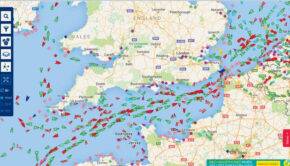Hazardous ice warning for iceboating
Published on February 16th, 2023
Adequate conditions for iceboating are not always available, and they’ve been particularly challenging this season. Jay Whitehair, Vice Commodore of the New England Ice Yacht Association, offers this report:
As much as we all want to be taking advantage of spring sailing conditions, please be advised that this year’s weather patterns have produced some of the most unpredictable and inconsistent ice coverings most of us have seen in decades.
This warning is based on numerous reported accidents throughout New England, most notably, on lake Champlain alone three fishermen died in the past week.
A few points worth considering in these accidents: each of the victims was a frequent visitor to their area and likely assumed they knew the conditions due to their history and time on that ice surface. At least one of the victims died of hypothermia while dressed in a dry suit after being immersed in the ice water for a significant time – he was not able to extricate himself from the cold water and get back onto the ice surface. One of the victims passed away due to exposure yet was wearing a personal flotation device.
As a career fire rescue technician who specializes in ice rescue and SCUBA recovery of victims who have fallen through the ice, here are a few thoughts that I feel we all should consider: Ice boating is particularly hazardous if you find yourself having ‘sailed’ onto thin ice. The geometry of our runner base spreads our weight loading to a very low lb/sq foot ratio.
In other words, by the time your boat drops into the lake, you may likely be a great distance from an ice surface that can support your loaded body weight without your wide boat base. This will result in you having to break the ice surface back to a point where you can self extricate. This type of swimming is not only exhausting but very limited in time due to the cold water wreaking havoc on your body’s ability to maintain itself (whether or not your are in a dry suit).
All of us should ask ourselves, ‘Would I be able to self extricate if I fall through the ice?’ The time to sort this out is NOT while alone in ice water. If you carry a heavy body frame or are not a skilled swimmer, or if you have not practiced pulling yourself along a surface with ice claws in full gear (or better yet in warm water onto a dock or surface similar to an ice edge), then the answer is likely, ‘No… I don’t have those skills yet’.
More thoughts:
• Although wearing a dry suit is a great level of protection against hypothermia, it is not enough to keep you alive for a long duration.
• Ice claws are essential in many situations such as smooth wet ice but knowing how to use them *with an efficient swim kick* is key. Often, you will not be able to simply pull yourself up and onto a safe surface. Practice in warm water! Expect to need assistance from others.
• Life jackets are great but offer no thermal protection. Expect only a few minutes in ice water of ability to help yourself and a mere ten minutes of consciousness. Otherwise they keep you afloat for an unconscious rescue/recovery. The ideal life jacket for ice use is otter smooth on the front and will not hang up on jagged ice chunks as you pull yourself up and out.
• Never sail alone! Keep your buddies in sight and in mind.
• Have a throw rope and long rope available. An ice screw in your emergency kit can help pull a heavy person out. Set the screw in the ice and run the long rope through it – aids in preventing back slip of the victim.
• Call 911 immediately if anybody is in the water and unable to quickly extricate. Any prolonged exposure victims should be handled very gently (for cardiac reasons) and transported to the emergency department for evaluation. It is likely they will say they are fine…. until they are not.
• Only check conditions with others who have proper equipment. Sail in areas that are demonstrated as safe.
Have fun and sail safe!









 We’ll keep your information safe.
We’ll keep your information safe.